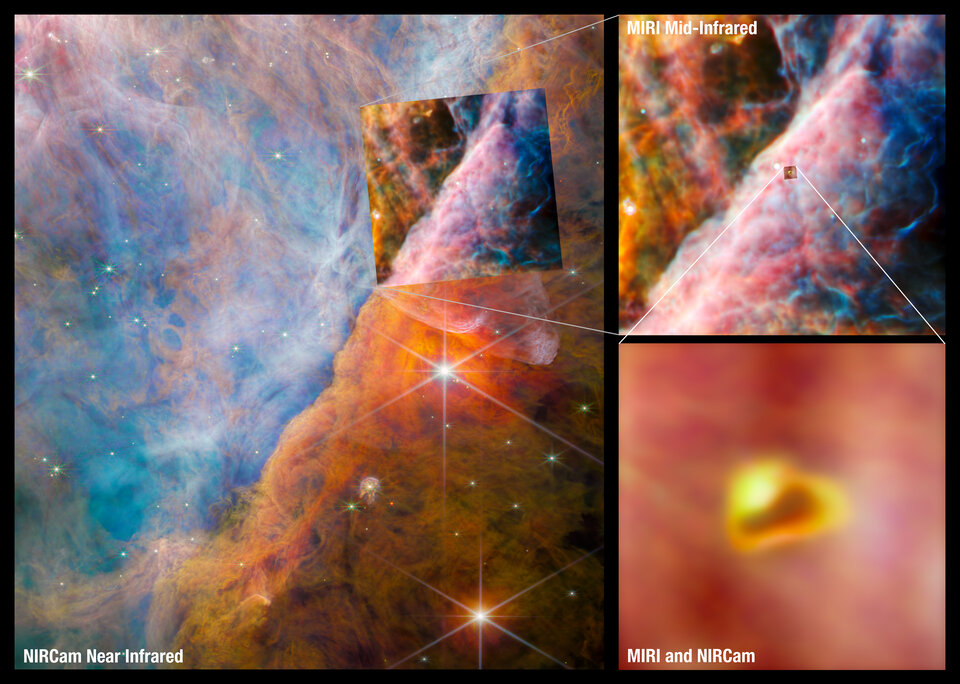Another Key Molecule for Life Found in Space by JWST
By Carolyn Collins Petersen
The search for life is an incredibly evocative driver of cosmic exploration. It captures our imagination to think that there might be living things out there somewhere else. That’s one reason why we point our eyes—and telescopes—to the stars.
For almost a year, James Webb Space Telescope (JWST) has shown astronomers the grandeur and beauty of the infrared universe. But, this infrared-sensitive observatory is also digging into the chemical underpinnings of life in the Universe. Recently researchers announced they used it to detect a carbon compound crucial to the formation of life. JWST found it in the Orion Nebula, in a young star system with a protoplanetary disk.
Romancing the Molecule
What the telescope spotted provides spectral evidence of a molecule called the “methyl cation” (notated as CH3+). While it doesn’t trigger life directly, it aids the formation of complex carbon-based molecules that are the basis of life. Scientists predicted back in the 1970s that this molecule would be found in space. But, it’s tough to detect. Radio telescopes have found many other molecules in protoplanetary disks. However, they can’t always “see” something like the methyl cation due to its unique properties. There is a way to see them in specific infrared spectra, but that light is blocked by Earth’s atmosphere. So, that leaves out ground-based infrared-sensitive facilities.
JWST orbits far from Earth’s influence and has a perfect view into clouds of gas and dust using its near-infrared spectrometer and mid-infrared instruments. It delivered a treasure trove of data about the methyl cation from those instruments to a consortium of scientists. According to science team member Marie-Aline Martine-Drumel of Paris-Saclay University in France, “Our discovery was only made possible because astronomers, modelers, and laboratory spectroscopists joined forces to understand the unique features observed by James Webb.”
What Connects this Molecule to Life?
From an astrochemist’s perspective, carbon compounds in space suggest that the materials for life likely exist throughout the Universe. This particular methyl cation reacts with other molecules and enables other chemical reactions that eventually result in additional complex carbon molecules. That’s why chemists think of it as a cornerstone of interstellar organic chemistry. Plus, it played a role in the eventual appearance of life on our own planet.
If this molecule developed elsewhere beyond Earth, it makes the potential development of life in star systems beyond our own much more likely. The fact that JWST was able to spot emission lines from this molecule in a busy protoplanetary disk environment is a crucial find. “This detection not only validates the incredible sensitivity of Webb but also confirms the postulated central importance of CH3+ in interstellar chemistry,” said Martin-Drumel.

The protoplanetary disk where JWST spotted the methyl cation is called d203-506. It’s fairly typical of star-forming regions where hot young stars bombard the birth cloud with UV. Most of the time, that radiation destroys molecules, but in this case, scientists think that it provided the energy that allowed the CH3+ molecule to form. Since nearby stars irradiate a lot of planet-forming disks, that means the formation process of the methyl cation could be widespread throughout these regions.
Relating Back to Earth
Our Sun and planets formed in essentially the same type of environment that d203-506 did. That is, in a stellar creche that included hot, massive, UV-bright stars existing alongside newly forming Sunlike stars. So, did the same irradiation also trigger the methyl cation in our birth cloud? Interestingly, analysis of meteorites (which trace conditions in the protoplanetary nebula) shows that it also experienced this same irradiation. And, here we are, 4 .6 billion years later, living on the only life-supporting planet that we know of—born in a disk heavily exposed to UV radiation.
That finding strengthens the idea that strong UV light doesn’t destroy some molecules and, in fact, pumps the production of it by providing the energy the cations need to form. According to Olivier Berné of the University of Toulouse, it’s a breakthrough for astrochemistry. “This clearly shows that ultraviolet radiation can completely change the chemistry of a proto-planetary disc. It might actually play a critical role in the early chemical stages of the origins of life by helping to produce CH3+ — something that has perhaps previously been underestimated,” he said.
For More Information
Webb Makes First Detection of Crucial Carbon Molecule in a Planet-forming Disc
Formation of the Methyl Cation by Photochemistry in a Protoplanetary Disk
The post Another Key Molecule for Life Found in Space by JWST appeared first on Universe Today.

June 28, 2023 at 07:06AM
via Universe Today read more...

Post a Comment